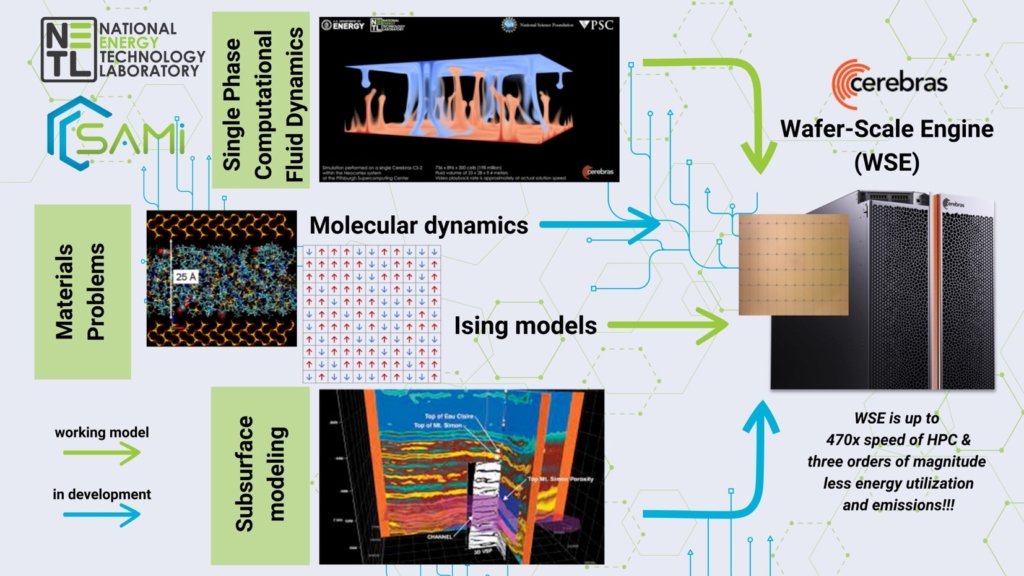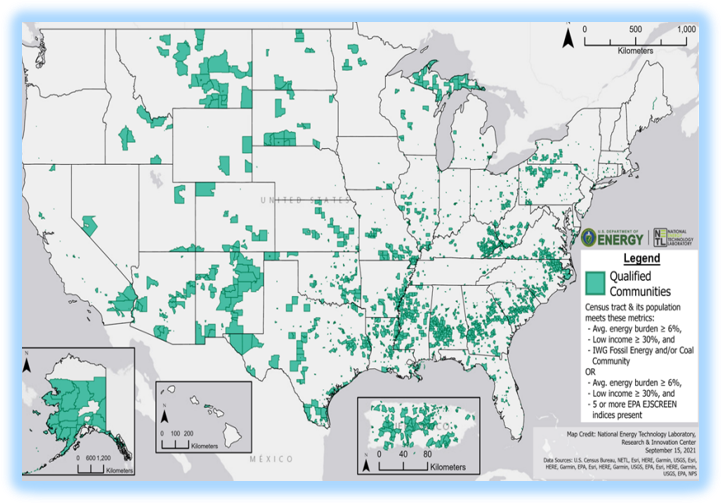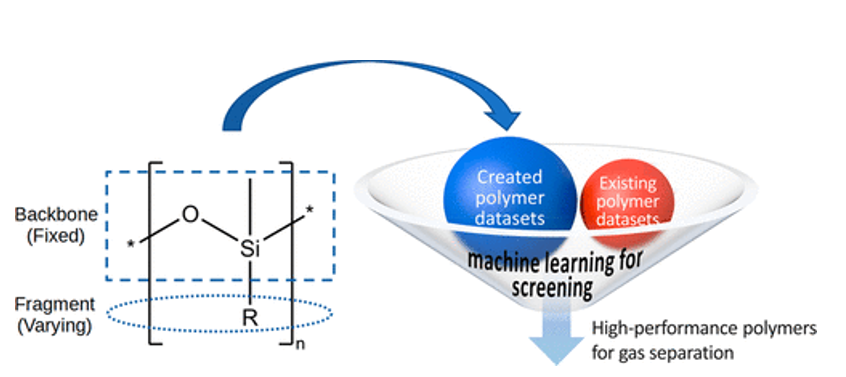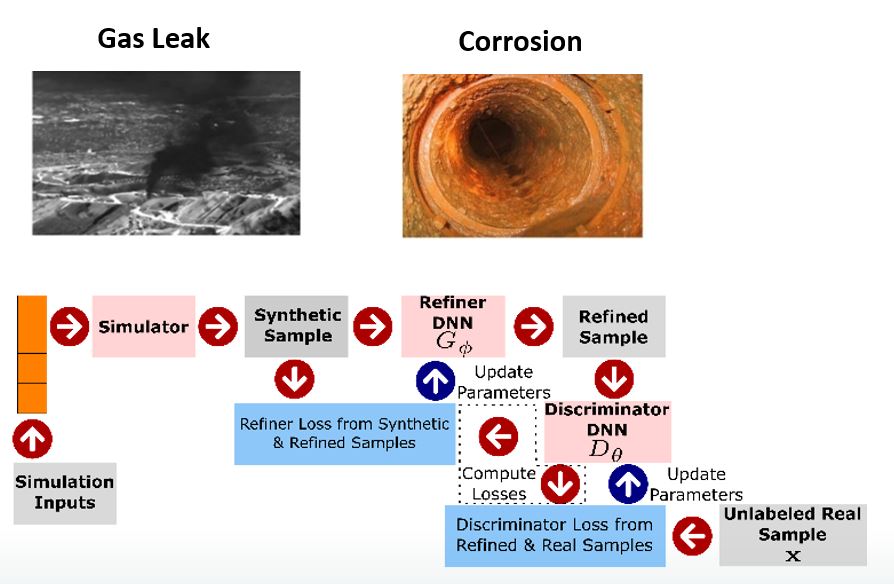NETL AI/ML Research
Big Data, Foundational Data, and AI Solutions
Wafer-scale engine Field equation Application programming interface (WFA)
Cutting-Edge, advanced AI computing & modeling, accelerating solutions to real world challenges
- The NETL-developed WFA programming interface for the wafer-scale engine allows researchers to tackle tough computational problems including materials, climate modeling, single-phase computational fluid dynamics, molecular dynamics, and AI-accelerated scientific computing.
- The wafer-scale engine has demonstrated solving the Rayleigh-Benard (R-B) natural convection problem up to 470x faster than traditional HPC with 3 orders of magnitude less energy usage and emissions.
Subsurface Trend Analysis (STA) Method and Tool
Enhancing knowledge discovery from unstructured data using a deep learning approach to support subsurface modeling predictions
- NETL advanced the subsurface trend analysis (STA) workflow with an AI-informed image segmentation/embedding model.
- The STA method was created to be a foundational technology, capable of assisting any subsurface predictive need.
- The image embedding tool uses convolutional neural networks (CNNs) to:
- Extract images from unstructured data
- Categorically label the images
- Create a repository for geologic domain postulation
- A case study on data available for the Gulf of Mexico shows the STA image embedding tool extracts and accurately labels images with 90% to 95% precision.
- The STA 2D Tool is available on NETL’s Energy Data eXchange® (EDX).
URC Resource Assessment Method/Tool
Federated-AI modeling for improving Natural Resource Assessments
- NETL’s geologic resource assessment AI Model helped uncover the largest unconventional deposit of magnetic rare earth elements (REE) in the U.S.
- The AI model was tested at a coal mine in Wyoming’s Powder River Basin and revealed the largest unconventional deposit of magnetic REEs discovered in the US.
- Featured in the Wall Street Journal – WSJ
- Also featured in energy trade journal, JPT
- In the last year, NETL has released five, peer-reviewed, data-driven products that help characterize unconventional critical minerals, all developed in support of SAMI.
Expanded use for Groundwater, Carbon Storage, H2, hydrocarbons, geothermal and more.
CO2 Smart EJ/SJ Route Planning Tool
Tool in Development under the Energy Data eXchange for Carbon Capture and Sequestration (EDX4CCS)
- The interactive smart tool will assist in planning routes for CO2 transport across the country. Explore the public database. The Pipeline Route Planning Database team published research in Data in Brief in December.
- Utilizes social and environmental justice database aligned to carbon storage systems to aid in decision-making around key future infrastructure placement and more.
- Contains geospatial layers representing federal and state regulations, pipeline route planning best-practices, critical environmental and social justice considerations.
- Researchers behind the tool met with representatives from industry on collaborative ideas and recently presented the tool at the FECM Interagency Carbon Transport Topic Team Meeting.
Finding High-performance Polymers for Gas Separation
Millions of polymers were screened using machine learning (ML) models
- Gaussian process regression (GPR)-based ML models were developed to predict permeability and selectivity using an in-house dataset containing experimental values
- A novel approach was developed to construct large polymer datasets
- ~15 million polymers were screened using ML models
- About 3,500 polymers of interest were identified for CO2/CH4 and CO2/N2 gas separation
- ML models helped identify high-performance polymers for gas separation with the potential of transforming the field
Carbon Management
CO2 Smart EJ/SJ Route Planning Tool
Tool in Development under the Energy Data eXchange for Carbon Capture and Sequestration (EDX4CCS)
- The interactive smart tool will assist in planning routes for CO2 transport across the country. Explore the public database. The Pipeline Route Planning Database team published research in Data in Brief in December.
- Utilizes social and environmental justice database aligned to carbon storage systems to aid in decision-making around key future infrastructure placement and more.
- Contains geospatial layers representing federal and state regulations, pipeline route planning best-practices, critical environmental and social justice considerations.
- Researchers behind the tool met with representatives from industry on collaborative ideas and recently presented the tool at the FECM Interagency Carbon Transport Topic Team Meeting.
Infrastructure and Environmental Resiliency
Advancing Diagnostic Efficiencies of Rotating Detonation Engine (RDE) with ML
Real-time diagnostic methods for gas turbines
- Objective: Application of computer vision and machine learning techniques to monitor detonation wave behavior in real time to experimental RDEs.
- Methods: Convoluted neural networks (CNNs) applied to high-speed conventional detonation imaging for image classification and object detection with You Only Look Once (YOLO) architecture, and time-series classification.
- Results: No single diagnostic structure outperforms the others in all metrics. Each method offers solutions uniquely beneficial to a given study based on primary objectives and constraints, justifying the need for a portfolio of ML capabilities with networks tailored to specific needs throughout the research community.
Monitoring Natural Gas Infrastructure
AI Enhanced Distributed Fiber Optic Sensing
Problem: Sensor data for various pipeline events are scarce for AI based classification
Solution: Develop Hybrid AI model to simulate distributed optical fiber sensor response for various pipeline integrity events
NETL’s pipeline sensors team tested new technologies in mid-February 2023 at the Southwest Research Institute test facility at a pilot-scale and recently signed a CRADA to continue field demonstrations.
Resources and Materials
AI-Enhanced Microstructural Analysis, Simulation, and Optimization for Electrochemical Device Electrodes
- Computer vision provides a rapid pathway from physical electrode to microstructural parameters
- Deep neural networks provide analysis from microstructural parameters to predict long-term performance metrics
- Connecting the two will produce a rapid electrode assessment tool
NETL researchers have used EDX® to publicly release the largest known bank of 3D electrode microstructures of solid oxide fuel and electrolysis cells (SOCs) for training ML tools.
Subsurface Trend Analysis (STA) Method and Tool
Enhancing knowledge discovery from unstructured data using a deep learning approach to support subsurface modeling predictions
- NETL advanced the subsurface trend analysis (STA) workflow with an AI-informed image segmentation/embedding model.
- The STA method was created to be a foundational technology, capable of assisting any subsurface predictive need.
- The image embedding tool uses convolutional neural networks (CNNs) to:
- Extract images from unstructured data
- Categorically label the images
- Create a repository for geologic domain postulation
- A case study on data available for the Gulf of Mexico shows the STA image embedding tool extracts and accurately labels images with 90% to 95% precision.
- The STA 2D Tool is available on NETL’s Energy Data eXchange® (EDX).
URC Resource Assessment Method/Tool
Federated-AI modeling for improving Natural Resource Assessments
- NETL’s geologic resource assessment AI Model helped uncover the largest unconventional deposit of magnetic rare earth elements (REE) in the U.S.
- The AI model was tested at a coal mine in Wyoming’s Powder River Basin and revealed the largest unconventional deposit of magnetic REEs discovered in the US.
- Featured in the Wall Street Journal – WSJ
- Also featured in energy trade journal, JPT
- In the last year, NETL has released five, peer-reviewed, data-driven products that help characterize unconventional critical minerals, all developed in support of SAMI.
Expanded use for Groundwater, Carbon Storage, H2, hydrocarbons, geothermal and more.
Finding High-performance Polymers for Gas Separation
Millions of polymers were screened using machine learning (ML) models
- Gaussian process regression (GPR)-based ML models were developed to predict permeability and selectivity using an in-house dataset containing experimental values
- A novel approach was developed to construct large polymer datasets
- ~15 million polymers were screened using ML models
- About 3,500 polymers of interest were identified for CO2/CH4 and CO2/N2 gas separation
- ML models helped identify high-performance polymers for gas separation with the potential of transforming the field













